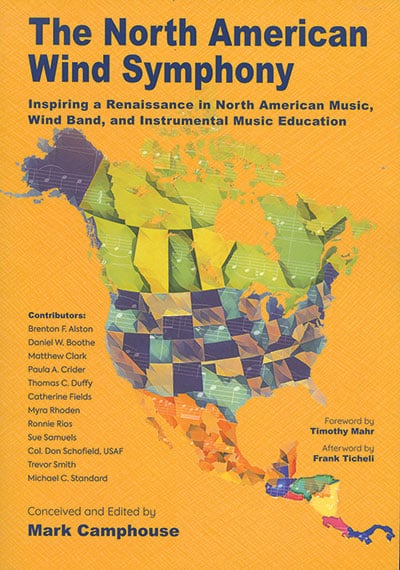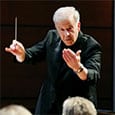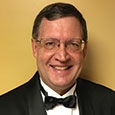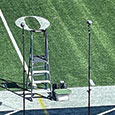Editor’s Note: This article features ideas in the recent book The North American Wind Symphony, published by GIA Publications ©2024. Mark Camphouse conceived and edited the project.

The title of this article comes from two iconic musicians: H. Robert Reynolds, Director Emeritus of University Bands, University of Michigan; and the late Vincent Cichowicz, 22-year Chicago Symphony Orchestra member and Northwestern University Professor of Trumpet. Their words strongly endorse the founding of the North American Wind Symphony (NAWS). I conceived, edited, and served as principal contributing author of a new GIA Publications book that details a vision for this ensemble, which would be the only full-time, professional, non-military wind band in North America.
Part One of the book, Musical Moonshot!, is a clarion call to found the North American Wind Symphony, North America’s first full-time, professional (civilian) wind band of the 21st century: why it is needed, what it will require, and what it can accomplish. Nearly half of the 116 pages of Part One are devoted to my detailed and comprehensive blueprint for this initiative. Four notable musicians (Frederick Fennell, Vincent Cichowicz, David Amram, and Paula A. Crider) and former U.S. Secretary of State Alexander M. Haig, Jr. expand on this proposal with their own thoughts and endorsements, as do the contributing authors. Additional endorsements include those by composers Adolphus Hailstork and Robert Sheldon, and conductors Greg Bimm and H. Robert Reynolds.

It is not a characteristically American trait to live in the past. Historically, Americans look ahead and thrive on challenge. We are an inventive and creative nation. The world has always marveled at America’s ability to see and live into the future.
In today’s classical music world, if there is one large instrumental performing medium that often looks to the past and carries on traditions more European than American, it is the symphony orchestra. The classical music establishment in America continues to be largely dedicated to imitating and perpetuating 18th- and 19th-century European repertoire, genres, and performance traditions. Many aspects of that imitation and perpetuation are important and enriching. However, an approach using a different medium with the goal of greater repertoire balance and sonic variety for audiences could also prove important and enriching. I love orchestral music. Several of my earliest compositions were written for orchestra. I have had some of my most enriching conducting experiences with orchestras, but the extent of the continuing genre imbalance concerns me.
If there is one large instrumental performing medium today that far more often looks at the present and to the future and carries on traditions that are more distinctly American, other than jazz, it is the wind band.
Frederick Fennell, founder of the Eastman Wind Ensemble in 1952, like American pioneers in other disciplines, saw into the future. Fennell’s innovative programming and many outstanding Eastman Wind Ensemble recordings made under his direction during the 1950s exemplify the extraordinarily high levels of American collegiate woodwind, brass, and percussion performance skills. Although performance excellence continues to rise today among college, university, and conservatory students, meaningful employment opportunities following graduation are in decline.
As we finish the first quarter of the 21st century, several questions come to mind.
• What new dimension can be added to Dr. Fennell’s pioneering innovation of over 70 years ago?
• What, for art’s sake, can begin to bring greater balance to professional music making and provide new opportunities for North American performing artists, composers, conductors, and performing arts managers?
• What, for our communities’ sake, can provide high-quality, enriching, entertaining, non-elitist, and distinctly North American alternatives for concert audiences?
• What, for our children’s sake, can assist in their developing a greater appreciation for and understanding of the art of music in North American schools?
• Very importantly, how can a musical organization strengthen friendship, trust, and cooperation among North American nations?
The North American Wind Symphony is one answer. It seeks to inspire a Renaissance in North American music, wind band, and instrumental music education. In addition to elevating the stature of the wind band as a wonderfully expressive and exciting medium, the NAWS initiative is also designed to strengthen music education and emphasize the acute need to create more meaningful jobs for especially gifted recent college/university and conservatory graduates.
The ethnic and racial makeup of the American mosaic is changing rapidly. We must recognize and address imbalances in racial and ethnic participation for school band programs, indeed instrumental music itself (including the symphony orchestra), to remain relevant. Failure to do so will have devastating consequences for instrumental music education in the next 25 years. The North American Wind Symphony will be deeply committed to diversity, equity, and inclusion in the hiring of and interaction with all staff and performance personnel as well as participants in NAWS educational initiatives.
Free from the somewhat isolated environments of academe and the military, the structural design, philosophy, and priorities of NAWS, both musical and non-musical, will necessitate its performance personnel and staff to understand the complex needs and compelling realities of culturally underserved communities. This will create a unique and well-informed team of quasi-cultural ambassadors to serve effectively both at home and abroad. NAWS staff, working with elected officials and civic leaders on globalization, immigration, border and environmental issues, economic revitalization, (and yes, the performing arts and arts education) will make important contributions by promoting goodwill and mutual understanding with citizens of all North American nations.
Detailed information on the timeframe, organizational structure, performance and staff personnel, budget, auditions, and first season performance schedule are also outlined in the book.
Three important “Prelude” periods will occur over a span of 24 months and progress logically to the first season. The ensemble will include 55 performers selected from applicants (pending auditions) from the three principal North American nations (the U.S., Canada, and Mexico) and seven Central American nations (Belize, Costa Rica, El Salvador, Guatemala, Honduras, Nicaragua, and Panama). Forty-three full-time staff members will be selected with a thorough screening process culminating with in-person interviews. Staff positions will be phased-in during the three prelude seasons.
The North American Wind Symphony will be designated as a nonprofit 501(c)(3) organization. With potential representation from ten North American nations, I hope NAWS will be viewed by the performance and music education communities and the public as a unique, dynamic, and innovative entrepreneurial organization, designed to elevate the stature of bands and provide audiences with an enhanced appreciation for the art of music being brought to life by world-class musical citizens and artist-teachers. With thanks to Abraham Lincoln and Aaron Copland, “We must think anew and act anew.”
The League of American Orchestras has a membership of over 1,800 orchestras in North America, including 400 youth orchestras. We are fortunate to have so many excellent professional symphony orchestras in North America. Some, without question, rank among the finest in the world. But it is most unfortunate that there isn’t even one full-time professional (non-military) wind band in 21st century North America. (Paradoxically, there are far more school, community, and military wind bands than orchestras in North America.)
President John F. Kennedy successfully captured the imagination of the American people (especially young Americans like me as a 7-year-old boy) with his passionate embrace of American exceptionalism and steadfast support of NASA in his May 25, 1961 address before a joint session of Congress when he stated: “I believe that this nation should commit itself to achieving the goal, before this decade is out, of landing a man on the moon and returning him safely to Earth.”
The American Moonshot, the Apollo 11 mission, was an inspiring display of American exceptionalism at its finest. I am firmly committed to a successful launching of a Musical Moonshot, an initiative with a none-too-subtle embrace of the symbolism and, yes, the audacity of President Kennedy’s goal of landing a man on the moon and returning him safely to Earth. I have dreamed of the Musical Moonshot initiative for about 40 years. I am deeply grateful to GIA Publications President Alec Harris for granting me the opportunity to share this dream with readers of this book.
I hope readers will reflect on the power and beauty of imagination, and witness not only the successful launching of the North American Wind Symphony, but also the successful launching of other forward-looking musical initiatives that will hopefully emerge and flourish in the years ahead with courage, persistence, and (respectful) audacity.
In addition to common borders, the United States, Canada, Mexico, and Central American nations also share many interests, opportunities, and challenges. There is a growing number of reasons why we should move closer to one another in a genuine effort to enhance friendship, trust, stability, and cooperation among North American nations. Clearly, the greatest wealth of North American nations lies in the talent of their people.
The multicultural, continental scope and design of the NAWS initiative is an integral part of its construction. Those factors, together with its exciting and forward-looking artistic vision, substantive educational initiatives, and unique philosophy and goals, promise to contribute significantly to the cultural enrichment and economic growth for communities everywhere. This, in turn, will enable greater discovery by audiences of the rich treasures of our priceless North American musical heritage.
Friends, colleagues, and students: This Musical Moonshot needs to be done, and I believe it can be done! If you feel this initiative has merit and contains “the right stuff,” to achieve its multifaceted goals, and if you feel this is “a daring idea whose time has come,” I encourage you to read this new book. I welcome you to join me in this effort.
***
Also Featured in the Book
The book begins with an inspirational foreword by Timothy Mahr, distinguished composer-conductor and St. Olaf College Professor Emeritus of Music, and ends with a very insightful afterword by Frank Ticheli, distinguished composer-conductor and USC Thornton School of Music Professor Emeritus of Composition. I wrote a substantial introduction for directors and students focusing on the power and beauty of imagination, thoughts about my education and career, advice for young musicians and parents about setting goals and establishing priorities, the college/conservatory selection process, and the need to appreciate and learn from the past while looking to the possibilities of the future.
I am particularly appreciative of the writings by the 12 contributing authors who are truly remarkable individuals, musicians, and educators. These authors span three generations and possess varied backgrounds and a wealth of expertise. They make astute observations and provide creative recommendations on topics found in all three parts of the book:
1. Music education
2. Composition, conducting, and performance
3. Ways to elevate the stature of the band medium to reach its full potential
I am also thrilled with the contributions of the three bright and gifted young emerging composers. Already in promising careers, they are the voices of the future in our profession.
Part Two provides a brief history of the National Band Association/United States Air Force Band Young Composer/Young Conductor Mentor Project. The program’s origins and impactful legacy are discussed by three leaders with the project – Paula A. Crider, U.S. Air Force Colonel Don Schofield, and me. More than a dozen mentees also offer their perspectives.
In Part Three, contributing authors examine important issues facing music education today and in the future. Topics include educational philosophy, concert programming, racial diversity in school band programs, curricula at the collegiate level, and the state of wind band composition, among others.
***
Facts in Brief
People
55 Full-Time Performance Personnel
43 Full-Time Staff in 6 areas of NAWS organizational structure: Administrative, Artistic, Development, Marketing and Communications, Community Engagement and Partnerships, Operations.
4 Full-Time Conducting Staff: Music Director and Principal Conductor, Associate Conductor, 2 Assistant Conductors
10 First Season Guest Conductors
6 First Season Guest Artist Soloists
A total of 104 first-season performances
of 41 programs by full NAWS, NAWS Chamber Players, NAWS Junior & Senior Symphonic Youth Bands, and NAWS Adult Community Symphonic Band
A 9-concert NAWS Summer Outdoor Concert Series
Fall Regional Performance Tour
Winter International Performance Tour (Mexico and Central America)
Spring State Performance Tour
NAWS Composer-in-Residence Program:
world premiere performances of NAWS commissioned works by three composers (One U.S., One Mexican/Central American, One Canadian)
NAWS Prelude Season Two:
4-day Continental Advisory Conference (CAC) attended by 100 invited representatives in 5 divisions: Artistic, Audience Development, Administrative and Management, Organizational Structure/Authorizations/Fundraising, Associations and Industry. CAC will have 4 featured guest speakers.
Principal First Season Music Education Initiatives:
12 Young People’s Concerts
2 NAWS Junior & Senior Symphonic Youth Band Concerts*
2 NAWS Adult Community Symphonic Band Concerts**
2 NAWS Community Music Education Day Open House Events
NAWS Conducting Workshop for School Band Directors
NAWS Open Reading & Recording Session of works by regional composers (including student composers)
NAWS International Young Composers Symposium
NAWS International Young Conductors Symposium
Proposed Post-First Season Principal Music Education Initiative:
NAWS Fellowship Program for college/university/conservatory music students in the following 3 areas: Instrumental Performance Fellowship: woodwind, brass, percussion. (Fall)
Instrumental Arts Management Fellowship (Winter/Spring)
Wind Conducting Fellowship (Summer)
***
In accordance with NAWS DEI policy, young musicians from traditionally underrepresented backgrounds are especially encouraged to apply to applicable NAWS Music Education Initiatives.
There were 22 U.S. metro areas in 17 states that were under initial consideration as a home base location for NAWS. That has now been narrowed down to four metro areas in four states.
A 30-page precise itemization of the 3 “Prelude” Seasons and First Season expenditures totaling $15,459,572 can be found on pages 77-107 in the new GIA Publications book.
*Symphonic Youth Bands students receive two 60-minute private scholarship lessons per month and one 90-minute sectional coaching session per month with NAWS members.
**Adult Community Symphonic Band members receive weekly 90-minute sectional coaching sessions by NAWS members in preparation for their 2 first Season summer performances.





